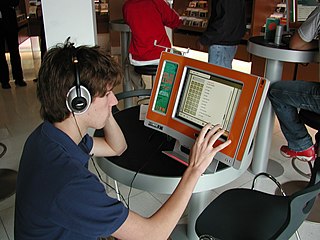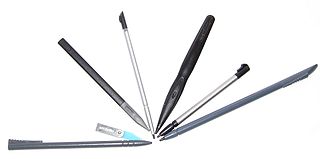Related Research Articles

A pointing device is a human interface device that allows a user to input spatial data to a computer. Graphical user interfaces (GUI) and CAD systems allow the user to control and provide data to the computer using physical gestures by moving a hand-held mouse or similar device across the surface of the physical desktop and activating switches on the mouse. Movements of the pointing device are echoed on the screen by movements of the pointer and other visual changes. Common gestures are point and click and drag and drop.

A graphics tablet is a computer input device that enables a user to hand-draw images, animations and graphics, with a special pen-like stylus, similar to the way a person draws images with a pencil and paper.

A touchscreen is a type of display that can detect touch input from a user. It consists of both an input device and an output device. The touch panel is typically layered on the top of the electronic visual display of a device. Touchscreens are commonly found in smartphones, tablets, laptops, and other electronic devices.

A tablet computer, commonly shortened to tablet, is a mobile device, typically with a mobile operating system and touchscreen display processing circuitry, and a rechargeable battery in a single, thin and flat package. Tablets, being computers, have similar capabilities, but lack some input/output (I/O) abilities that others have. Modern tablets largely resemble modern smartphones, the only differences being that tablets are relatively larger than smartphones, with screens 7 inches (18 cm) or larger, measured diagonally, and may not support access to a cellular network. Unlike laptops, tablets usually run mobile operating systems, alongside smartphones.

In computing, multi-touch is technology that enables a surface to recognize the presence of more than one point of contact with the surface at the same time. The origins of multitouch began at CERN, MIT, University of Toronto, Carnegie Mellon University and Bell Labs in the 1970s. CERN started using multi-touch screens as early as 1976 for the controls of the Super Proton Synchrotron. Capacitive multi-touch displays were popularized by Apple's iPhone in 2007. Multi-touch may be used to implement additional functionality, such as pinch to zoom or to activate certain subroutines attached to predefined gestures using gesture recognition.

Pen computing refers to any computer user-interface using a pen or stylus and tablet, over input devices such as a keyboard or a mouse.
A text entry interface or text entry device is an interface that is used to enter text information in an electronic device. A commonly used device is a mechanical computer keyboard. Most laptop computers have an integrated mechanical keyboard, and desktop computers are usually operated primarily using a keyboard and mouse. Devices such as smartphones and tablets mean that interfaces such as virtual keyboards and voice recognition are becoming more popular as text entry systems.

A dual-touchscreen is a computer or phone display setup which uses two screens, either or both of which could be touch-capable, to display both elements of the computer's graphical user interface and virtualized implementations of common input devices, including virtual keyboards. Usually, in a dual-touchscreen computer or computing device, the most persistent GUI elements and functions are displayed on one, hand-accessible touchscreen alongside the virtual keyboard, while the other, more optically-centric display is used for those user interface elements which are either less or never accessed by user-generated behaviors.

In computing, a stylus is a small pen-shaped instrument whose tip position on a computer monitor can be detected. It is used to draw, or make selections by tapping. While devices with touchscreens such as newer computers, mobile devices, game consoles, and graphics tablets can usually be operated with a fingertip, a stylus provides more accurate and controllable input. The stylus has the same function as a mouse or touchpad as a pointing device; its use is commonly called pen computing.
The history of tablet computers and the associated special operating software is an example of pen computing technology, and thus the development of tablets has deep historical roots. The first patent for a system that recognized handwritten characters by analyzing the handwriting motion was granted in 1914. The first publicly demonstrated system using a tablet and handwriting recognition instead of a keyboard for working with a modern digital computer dates to 1956.

Microsoft Tablet PC is a term coined by Microsoft for tablet computers conforming to hardware specifications, devised by Microsoft and announced in 2001, for a pen-enabled personal computer, and running a licensed copy of Windows XP Tablet PC Edition operating system or a derivative thereof.

A 2-in-1 laptop, also known as 2-in-1 PC, 2-in-1 tablet, laplet, tabtop, laptop tablet, or simply 2-in-1, is a portable computer that has features of both tablets and laptops.

Lenovo Yoga is a line of consumer-oriented laptop computers, tablets, and all-in-one computers designed, developed and marketed by Lenovo, named for their ability to assume multiple form factors due to a hinged screen. The line currently competes against other 2-in-1 PCs such as the HP Spectre.

Microsoft Surface is a series of touchscreen-based personal computers, tablets, and interactive whiteboards designed and developed by Microsoft, most of them running the Windows operating system. They are designed to be premium devices that set examples for manufacturers of other Windows-compatible products. It comprises several generations of hybrid tablets, 2-in-1 detachable notebooks, a convertible desktop all-in-one, an interactive whiteboard, and various accessories, many with unique form factors. The majority of devices in the Surface lineup are based on Intel processors and compatible with Windows 10 or Windows 11.

The Samsung Ativ Q was a 13.3-inch convertible laptop to be manufactured by Samsung. Unveiled at a Samsung Premiere event on June 20, 2013, the tablet was to run Windows 8, but also shipped with software that also allowed it to run the Android operating system. The Ativ Q's hardware was also distinguished by multiple folding states and a high resolution display.

An active pen is an input device that includes electronic components and allows users to write directly onto the display of a computing device such as a smartphone, tablet computer or ultrabook. The active pen marketplace has long been dominated by N-trig and Wacom, but newer firms Atmel and Synaptics also offer active pen designs.
Surface Mini is an unreleased tablet computer that Microsoft designed as the successor to the Surface 2 in the Microsoft Surface family. The device has a Qualcomm Snapdragon 800 processor and a 7.5-inch (19 cm) 4:3 aspect ratio touchscreen display that defaults to portrait mode. Like its predecessor, the Surface Mini runs Windows RT 8.1, a mobile operating system that was designed for the ARM architecture and has limitations including an inability to install Win32 applications; programs can only be installed from the Windows Store.

A foldable smartphone is a smartphone with a folding form factor. It is reminiscent of the clamshell design of many earlier feature phones. Some variants of the concept use multiple touchscreen panels on a hinge, while other designs utilise a flexible display. Concepts of such devices date back as early as Nokia's "Morph" concept in 2008, and a concept presented by Samsung Electronics in 2013, while the first commercially available folding smartphones with OLED displays began to emerge in November 2018.
The Surface Duo is a dual-touchscreen Android smartphone manufactured by Microsoft. Announced during a hardware-oriented event on October 2, 2019, and officially released on September 10, 2020, it is part of the Microsoft Surface series of touchscreen hardware devices, and the first device in the line that does not run Windows. It also marks Microsoft's first smartphone since the dissolution of Microsoft Mobile and the Windows Phone platform.
The Surface Neo is an unreleased dual-touchscreen 2-in-1 PC that was unveiled by Microsoft on October 2, 2019. Slated to be part of the Microsoft Surface family of devices, the Surface Neo was designed to be used in various "postures" for different use cases and multitasking scenarios involving its screens, and feature Windows 10X—a variant of Windows 10 designed exclusively for dual-screen devices. However, as of December 2023, over four years after the Surface Neo was announced, it is still unreleased, likely rendering it vaporware.
References
- ↑ "Microsoft readying Courier touch-screen tablet". The Daily Telegraph. 2009-09-23. Retrieved 2009-09-23.
- ↑ "Codex and InkSeine -- the roots of Microsoft's Courier?". endgadget. 2009-09-24. Retrieved 2009-09-25.
- 1 2 3 4 5 Foley, Mary Jo (2009-09-29). "Microsoft's Courier tablet: A Franklin Covey planner on steroids?". ZDNet . Retrieved 27 November 2009.
- 1 2 "Microsoft Cancels Innovative Courier Tablet Project". Gizmodo. 2010-04-29. Retrieved 2010-04-29.
- 1 2 Rubin, Ross. "Surface Neo: How Microsoft's two-screened tablet updated a ten-year-old idea". ZDNet. Retrieved 2020-02-26.
- ↑ Allan, Darren (3 February 2020). "Microsoft Surface Neo: release date, news and features". TechRadar. Retrieved 2020-02-26.
- ↑ "Courier: First Details of Microsoft's Secret Tablet". Gizmodo. 2009-09-22. Retrieved 2009-09-22.
- 1 2 3 4 5 6 Paul, Ian (2009-11-05). "Microsoft Courier: A Feature Breakdown". PC World . Retrieved 25 November 2009.
- 1 2 Patel, Nilay (2010-03-05). "Microsoft's Courier 'digital journal': exclusive pictures and details". Engadget . Retrieved 5 March 2010.
- ↑ "Microsoft's dual-screen Courier booklet emerges, isn't near production". Gizmodo. 2009-09-23. Retrieved 2009-09-28.
- ↑ "Speculation About the "Courier" Project". The official Microsoft Blog. 2010-04-29. Retrieved 2010-05-02.
- ↑ "Microsoft reportedly working on Courier-like device for taking digital notes". The Verge. Retrieved 2017-10-27.
- ↑ "Microsoft is working on a foldable device with a focus on pen and digital ink". Windows Central. Retrieved 2017-10-27.
- ↑ "Microsoft may revive 'Courier' concept with foldable tablet focused on digital ink". TechRadar. Retrieved 2017-10-27.
- ↑ "Microsoft reportedly tests a Courier-like folding digital notebook". Engadget. Retrieved 2017-10-27.